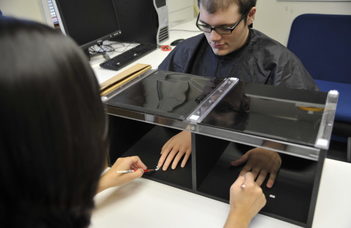Proprioception but not cardiac interoception is related to the rubber hand illusion

The publication of Áron Horváth, a student of the Doctoral School of Psychology at Eötvös Loránd University, Ferenc Köteles, and their research colleagues Eszter Ferentzi, Tamás Bogdány, Tibor Szolcsányi and Michael Witthöft on the relationship between interoceptive accuracy and the rubber hand illusion has been published.
Abstract
The rubber hand illusion (RHI) is a widely used tool in the study of multisensory integration. It develops as the interaction of temporally consistent visual and tactile input, which can overwrite proprioceptive information. Theoretically, the accuracy of proprioception may influence the proneness to the RHI but this has received little research attention to date. Concerning the role of cardioceptive information, the available empirical evidence is equivocal. The current study aimed to test the impact of proprioceptive and cardioceptive input on the RHI.
60 undergraduate students (32 females) completed sensory tasks assessing proprioceptive accuracy with respect to the angle of the elbow joint, a heartbeat tracking task assessing cardioceptive accuracy (the Schandry-task) and the RHI.
We found that those with more consistent joint position judgements (i.e., less variable error) in the proprioceptive task were less prone to the illusion, particularly with respect to disembodiment ratings in the asynchronous condition. Systematic error, indicating a systematic distortion in position judgements influenced the illusion in the synchronous condition. Participants with more proprioceptive bias toward the direction of the rubber hand in the proprioceptive test reported a stronger felt embodiment. The results are in accordance with Bayesian causal inference models of multisensory integration. Cardioceptive accuracy, however, was not associated with the strength of the illusion.
We concluded that individual differences in proprioceptive processing impact the RHI, while cardioceptive accuracy is unrelated to it. Theoretical and practical relevance of the findings are discussed.
The full article is available here.

